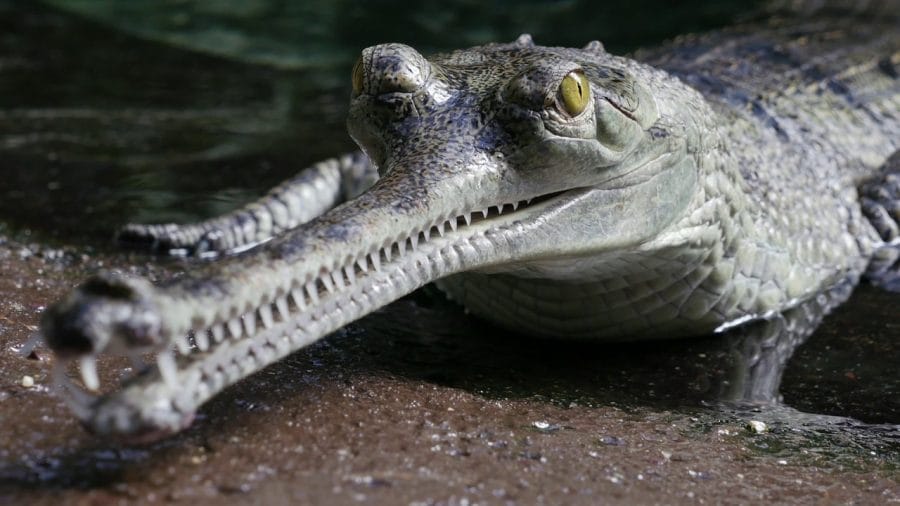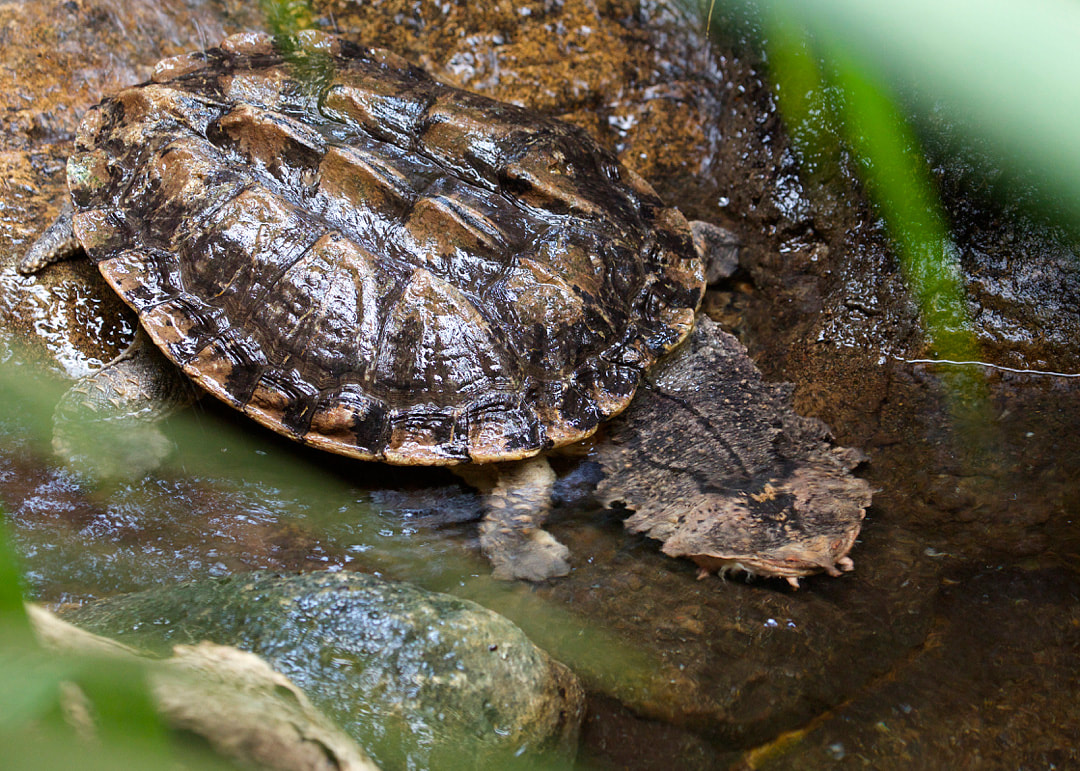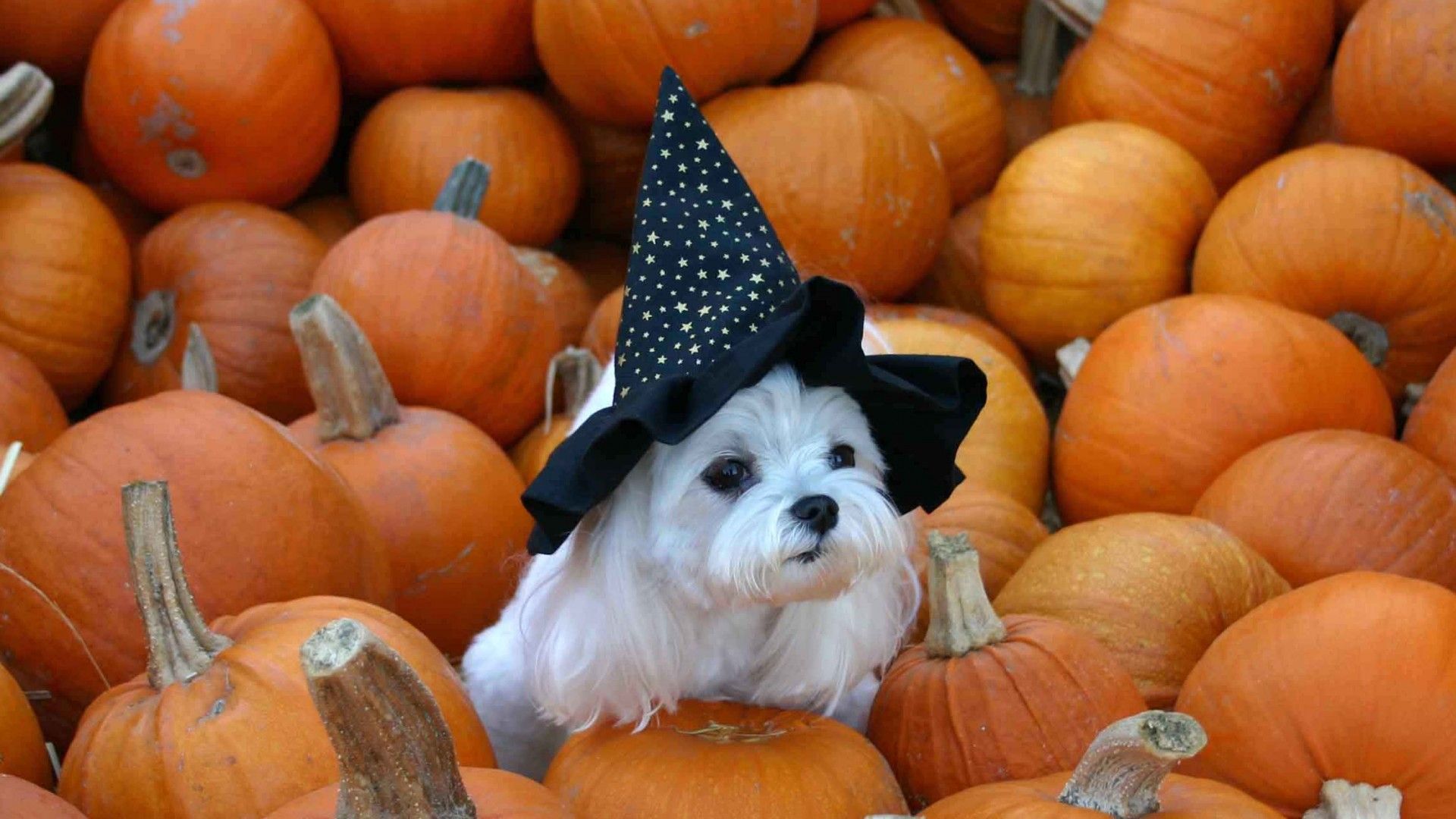Scary Reptiles & Amphibians
"24. Hairy Frog aka Wolverine Frog, Horror Frog
Latin name: Trichobatrachus robustus
Scary feature: Hairy thighs & broken bone claws
Range: Central Africa
Size: Length: 4.3 inches (11 cm)
Diet: Slugs, spiders, beetles, grasshoppers, & myriapods
...The hairy frog, also called the wolverine frog, looks like it’s part werewolf.
The male has hairy-like structures growing on its upper thighs. These 'hairs' are actually arteries & skin, that may be used to take in more oxygen.
Another bizarre feature of this frog is that, when threatened, its claws are extended after breaking through the toe bones.
After the frog relaxes, the claws retract & the toes regenerate.
25. Thorny Dragon Lizard
Latin name: Moloch horridus
Scary feature: false head
Range: Australia
Size: Length: 7.9 inches
Diet: Mostly ants
Spiky skin & 2 large, scaly horns on its head make the thorny dragon lizard a frightful sight. But unless you’re an ant, you have nothing to fear.
To deter predators, it can flash its 'false head' or puff itself up.
26. Crocodile Monitor
Latin name: Varanus salvadorii
Scary feature: Long, powerful tail
Range: New Guinea
Size: Length: 7- 13 ft. (2.1- 3.9 m); Weight: Up to 200 lbs. (90 kg)
Diet: Small mammals, birds, eggs, frogs, snakes, & carrion
Resembling a scary dinosaur, the crocodile monitor is one of the world’s longest lizards.
Mostly dark green with yellow spots, a long neck, & sharp teeth and claws, this lizard is distinguished by its blunt snout & an extremely long tail that it uses as a tool for climbing trees & as a whip in defense.
It’s also believed that it may be the inspiration for the velociraptors from the Jurassic Park franchise...
27. Giant Spitting Cobra
Latin name: Naja ashei
Scary feature: Spits out venom that causes temporary blindness
Range: Eastern & northeastern Africa
Size: Length: 4.3- 6.6 ft. (1.3- 2.0 m)
Diet: Birds, eggs, lizards, rats, smaller snakes, & insects
The giant spitting cobra is the world’s largest of all the world’s spitting cobra species.
As its name suggests, it spits out venom when threatened.
But this species can spray out a much larger volume at one time than other species with an accuracy of up to 6.6 feet.
Because its venom can cause temporary blindness, the cobra always aims for the face of its predator.
28. Snake-necked Turtle
Latin name: Chelodina
Scary feature: Snake-like neck
Range: Australia & southern New Guinea
Size: Length: 10 inches
Diet: Insects, worms, tadpoles, frogs, small fish, & crustaceans
If you only saw the long neck & head of this turtle sticking out of the water, you’d think it was a snake, but it’s really a snake-necked turtle.
It looks creepy but is harmless & spends its time walking on the river bottom searching for prey to vacuum up into its mouth.
29. Gharial
Latin name: Gavialis gangeticus
Scary feature: Long, sword-like snout with 100 razor-sharp teeth
Range: Northern parts of the Indian subcontinent
Size: Length: 11- 20 ft. (3.35- 6 m); Weight: 351- 551 lbs. (159- 250 kg)
Diet: Fish, frogs, crustaceans
Crocodiles are scary animals anyway, but what about one with a long, sword-like snout that looks like it could slice you up for dinner with its 100 razor-sharp teeth?
That monster would be a gharial, a beast from India with a weird, bulbous growth on its snout.
Not something you would want to cuddle up to, but gharials are unlikely to hurt you. They are specialized fish hunters & tend to stick to that.
30. Yellow-lipped Sea Krait
Latin name: Laticauda colubrina
Scary feature: Venomous bite
Range: Eastern Indian & western Pacific oceans.
Size: Female length: 50 inches (128 cm) long; Male length: 30 inches (75 cm)
Diet: Small fish & eels
The yellow-lipped sea krait is a blue sea snake with distinctive black stripes, a yellow snout, & a paddle-like tail that is used for swimming.
It has a potent venom that it uses when preying on small fish & eels.
It has a pink tongue that resembles a worm which the turtle wiggles to lure fish into its mouth. Its bite is powerful enough to cause serious injury.
32. Coral Snake
Latin name: Micrurus fulvius
Scary feature: Potent venom
Range: Southeastern United States
Size: Length: 18- 20 inches; (45- 50 cm)
Diet: Smaller snakes, frogs, lizards, small rodents, nestling birds
Recognized by its vibrant colors & patterns of red with black (or yellow) bands, the coral snake is considered one of the most venomous snakes in the world.
Fortunately, it doesn’t carry much of its venom in its fangs.
Plus, the fangs are small & fixed instead of contracting, making them too weak to do much damage.
33. Black Mamba
Latin name: Dendroaspis polylepis
Scary feature: Powerful venom
Range: Sub-Saharan Africa
Size: Length: 6.6- 14.8 ft. (2- 4.5 m)
Diet: Birds & small mammals (rodents, bats, bushbabies)
The most feared snake in Africa, the black mamba is highly venomous & capable of killing a human within just a few minutes without antivenom treatment.
34. Mata Mata Turtle
Latin name: Chelus fimbriata
Scary feature: Triangular head & long, prickly neck
Range: South America
Size: Length: 16- 18 inches; Weight: Up to 33 lbs.
Diet: Fish & aquatic invertebrates
Unlike any other turtle, the mata mata has a triangular head & a really long neck that’s lined with ragged skin flaps & prickly barbels.
While these features appear frightening, they camouflage the turtle in shallow, sandy streams.
The mata mata moves very little & can’t chew, so it just sucks its prey into its mouth like a vacuum cleaner.
35. Komodo Dragon
Latin name: Varanus komodoensis
Scary feature: Huge dinosaur-like body & venomous saliva
Range: Indonesian islands of Komodo, Rinca, Flores, & Gili Motang
Size: Length: Up to 10 ft. (3 m); Weight: 150 lbs. (70 kg)
Diet: Birds, invertebrates, mammals (Timor deer) & carrion
Resembling a small dinosaur, the Komodo dragon is the world’s largest lizard...
It has venomous saliva, scaly skin, a deeply forked tongue, & a tail that’s as long as its body. It rarely attacks humans but has been known to kill people.
36. Saltwater Crocodile
Latin name: Crocodylus porosus
Scary feature: Strongest bite force of any animal
Range: East India, northern Australia, Micronesia, & the Sundaic region
Size: Length: 10- 20 ft. (3- 6.1 m); Weight: Up to 2,370 lbs. (1,075 kg)
Diet: Fish, birds, mammals
One of the largest crocodiles in the world, this crocodile is unique from others of its kind.
Not just because it lives in saltwater, but also because it has a larger head, wider snout, & broader body.
Moreover, it’s confirmed to have the strongest bite force ever recorded of any animal, & they’re aggressive.
37. Satanic Leaf-tailed Gecko
Latin name: Uroplatus phantasticus
Scary feature: Horns & red eyes
Range: Madagascar
Size: Length: Up to 3.5 inches (including tail)
Diet: Insects such as moths, crickets, & spiders
...It has a tail & body that perfectly mimic a leaf in coloration, shape, & other camouflage details such as leaf veins & insect damage.
Some species have horny projections on their head & red eyes, but these geckos are harmless to humans.
38. Poison Dart Frog
Latin name: Dendrobatidae
Scary feature: Excretes a lethal toxin
Range: South America
Size: Length: 0.6- 2.4 inches (1.5- 6 cm); Weight: 0.07- 0.25 oz. (2 to 7g)
Diet: Insects, ants, spiders
Some of the scary animals on this list just look that way but are perfectly harmless. The poison dart frog is just the opposite.
It’s a colorful, attractive frog but is one of the world’s most dangerous creatures.
This rainforest frog excretes a powerful toxin that can cause paralysis, sickness, &even death. This is why indigenous tribes once used it in their blow-darts.
39. Gila Monster
Latin name: Heloderma suspectum
Scary feature: Venomous but its exaggerated reputation is scarier
Range: Southwestern United States & Mexico
Size: Length: Up to 2 ft. (0.61 m); Weight: 5 lbs. (2.26 kg)
Diet: Small birds, frogs, smaller lizards, insects, carrion, & small mammals
The only venomous lizard endemic to the United States, the Gila monster is a large lizard with claws, a forked tongue, & pale spots on is scaly dark skin.
Many rumors have exaggerated this lizard’s reputation. It is venomous but is so slow-moving that it’s rarely a threat to humans."
everywherewild.com/scary-animals
Scary Halloween Critters











No comments:
Post a Comment